Are You Underinvesting in Media?
During a recent conversation with a client, a hospice executive director described digital media as “nebulous” – a word that perfectly sums up the confusion many leaders feel about media investments beyond a line item in the budget.
But in today’s rapidly evolving home-based care landscape, where competition is on the rise and caregivers and patients increasingly turn to online platforms for their healthcare information, uncertainty is no longer an option. The real question isn’t whether to invest in media, but how wisely you’re doing it.
In 2025, it’s time to reexamine your media investments with a sharper lens. Are you effectively connecting with your audience or are you letting valuable opportunities pass you by?
Before we dive in, let’s quickly define what media as a whole encompasses:
- Digital media includes online ads, such as paid social media, display (banner) ads, sponsored search and video ads. Digital media allows for precise targeted, data-driven approaches to engage audiences directly where they spend their time in online spaces.
- Traditional media includes print ads, TV, radio and outdoor advertising. Traditional media provides a broad reach and can be used for brand awareness on physical or broadcast formats.
So how can you tell if your organization is underinvesting in media? Well, let’s break it down.
Signs You May Be Underinvesting and How to Fix the Gaps
1. You’re Sticking with the Status Quo
If your marketing team’s media strategy hasn’t evolved in years or doesn’t exist, it may be time to shake things up to stay competitive. Relying on the same media spending habits prohibits proactive investment in updated creative assets and carefully researched placements that can keep you top of mind as a provider in your service area.
The Fix: Break free from the status quo by conducting an honest evaluation of your current media strategy to identify areas of stagnation. Start by compiling your media contracts and ad placements, gathering performance metrics, and comparing them to current market trends. This thorough analysis will help you understand what’s working and where investment opportunities for growth exist.

2. You Lack a Clear Marketing Strategy
A well-structured marketing plan is essential to ensure that your media investments align with your organizational goals. Relying on ad hoc campaigns or spreading your budget too thin across numerous tactics can dilute your efforts and prevent you from achieving meaningful results.
The Fix: Begin with a clear vision for your marketing efforts that ties directly to your organizational KPIs. Are you aiming for more caregiver referrals, stronger brand recognition in a new service area, or to establish yourself as a preferred provider amidst rising competition? Defining your “why” will help you focus resources and ensure your media investments are guided by strategic decisions.
Once your strategy is established, align it with actionable tactics and a multi-pronged media approach. For example, if your goal is to promote a new hospice location, you may consider a mix of targeted social media ads directed at caregivers, geo-fencing campaigns around nearby hospital systems, and local billboards to boost visibility.
Need a refresher on strategy versus tactics?

3. You Don’t Know Where Your Audience Is Spending Their Time
Many organizations stick to what they feel is best when placing media and just hope it reaches their intended audience. In today’s digital age, knowing where your audience spends their time is crucial. Without understanding their media consumption habits, it’s highly likely that your media investments are misaligned with the platforms that matter most to your audience.
The Fix: Understanding your audience’s needs, preferences and behaviors is essential to creating impactful campaigns. For home-based care providers, relying solely on basic targeting methods like age, gender or location will no longer suffice for making informed decisions about ad placements.
Instead, invest in data-driven insights to better understand your audience’s media consumption habits and profiles. Advanced tools can help you identify the platforms, channels and publications your audience genuinely engages with and the messaging that will have the highest impact. For example, if you know your family caregiver audience is most active on Facebook, you can strategically allocate resources there, avoiding wasted ad spend on less effective channels like Instagram and X.
For help identifying media consumption habits to inform your investments, Transcend’s TRi™ reports include these valuable insights.

4. You Aren’t Monitoring Performance on Media Investments
Failing to monitor the performance of your media investments can lead to wasted resources and missed opportunities. Without clear insights into what’s working and what isn’t, your organization risks continuing ineffective strategies while neglecting high-performing channels that could drive better results. Tracking performance is essential to ensure your media dollars are being spent wisely and delivering the desired outcomes.
The Fix: To keep your brand ahead of the curve, leverage analytics to track key metrics, such as website traffic, lead conversions and engagement on existing media to identify your strengths and areas for improvement. By benchmarking your performance against industry standards for similarly sized healthcare organizations, you can then reallocate resources to platforms where your audience is most active and refine your messaging to stand out. By combining these insights, you can develop a competitive strategy that maximizes ROI. To get started on your monitoring, compare your CTR (click-through-rate) and VCR (video-completion rate) against these industry specific benchmarks:
- Display: 0.06% CTR
- Facebook: 0.5% CTR
- Facebook: 15% VCR
- Pre-Roll 15-second: 70% VCR
- Pre-Roll 30-second: 64% VCR
- Sponsored Search: 5% CTR
Tip: While traditional media may not offer as many metrics as digital media, you can still evaluate performance using print readership data, TV viewership statistics, and average traffic numbers for outdoor advertising.
Bonus Tip: Media effectiveness isn’t just about arbitrary benchmarks! Tracking where your referrals come from via custom forms and UTM codes can help you quantify if your digital media is generating qualified referrals for your services. Similarly, your intake and access teams should track where all referrals come from to give you global insights on where to apply your resources and what’s working.

5. You’re Not Diversifying Your Media Investment Mix
Relying too heavily on traditional media or focusing solely on one type of digital platform limits your reach and impact. A lack of diversification in your media buying mix can cause you to miss out on opportunities to connect with key audiences through channels they prefer. With more caregivers and patients consuming content across various digital and traditional platforms, an overreliance on one approach can leave gaps in your brand’s visibility.
The Fix: Develop a well-rounded media strategy that balances digital and select traditional channels. For example, combine targeted digital ads on social media with video ads on streaming platforms and supplement these with traditional outlets like radio or print for brand awareness. Diversifying your media mix ensures you meet your audience where they are, maximizing your reach and increasing the effectiveness of your campaigns. An intentional mix of platforms creates a stronger presence and a higher ROI.
The Cost of Underinvestment and the Value of Investing in Growth
Underinvesting in media doesn’t just hinder growth – it can have widespread consequences. Insufficient visibility can lead to fewer physician and caregiver referrals and missed opportunities to stand out from competitors. On the other hand, strategic media investments can deliver significant returns, strengthen organizational goals, enhance brand loyalty, and drive sustainable growth. While every provider is unique, it’s not uncommon for single-site organizations to invest 5-6 figures annually in media as an effective way to drive real, measurable success.
Recognizing underinvestment is the crucial first step toward improvement. So, give yourself credit for taking that step today by identifying the signs and exploring the solutions. Now, it’s time to take action, address the media investment gaps, and supercharge your marketing for long-term success!
Your marketing efforts should work as hard as you do. Let us help you craft a media strategy that aligns with your goals, engages your target audience, and positions your organization ahead of competitors. Send us an email at [email protected] to chat next steps.











